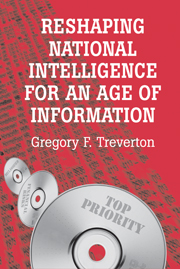Book contents
- Frontmatter
- Contents
- Foreword
- Preface
- Note on sources
- 1 The imperative of reshaping
- 2 The world of intelligence beyond 2010
- 3 The militarization of intelligence
- 4 Designated readers: the open source revolution
- 5 Spying, looking, and catching criminals
- 6 The intelligence of policy
- 7 A reshaped intelligence
- Index
3 - The militarization of intelligence
Published online by Cambridge University Press: 23 May 2010
- Frontmatter
- Contents
- Foreword
- Preface
- Note on sources
- 1 The imperative of reshaping
- 2 The world of intelligence beyond 2010
- 3 The militarization of intelligence
- 4 Designated readers: the open source revolution
- 5 Spying, looking, and catching criminals
- 6 The intelligence of policy
- 7 A reshaped intelligence
- Index
Summary
Imagine again those info-warriors of the 21st century, for if there is anything certain about the world beyond 2010, it is that U.S. soldiers will be sent into conflicts somewhere in the world. Wherever they fight, their “battlefield” will be radically transformed. The density of soldiers and formations on the battlefield has been diminishing for centuries, and that trend will be dramatically visible by 2010. Given the precise targeting of modern weapons, massed formations will only become tempting targets. And if the battlefield beyond 2010 is less dense than the battlefields of the past, it will also be broader. The distinction between the battlefield and the rest of society has also been eroding for some time, as industrial capacity has become critical to the ability to wage war. This trend, too, will accelerate by 2010, both as particular installations (such as communications nodes) become more and more critical to fighting wars and as the “military” and “civilian” purposes of those installations become more intertwined.
Most of 2010's info-warriors will be far from the battlefield as it used to be conceived, far from the violence and destruction. They will be operating sensors capable of seeing and weapons capable of striking over long distances. They may fly airplanes, but they will do so by remote control, not by sitting in the planes' cockpits. Some of the sensors they employ may be housed in satellites, but not many, for satellites are too far away and pass too quickly to be of real help to the info-warriors.
- Type
- Chapter
- Information
- Publisher: Cambridge University PressPrint publication year: 2001

